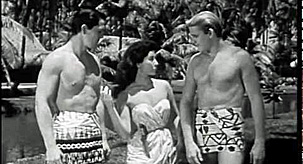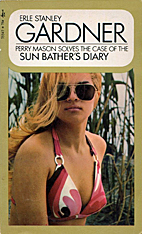Tue 2 Aug 2016
An Old Time Radio Review by Michael Shonk: BEYOND REASONABLE DOUBT (1939-40).
Posted by Steve under Old Time Radio , Reviews[13] Comments
by Michael Shonk
BEYOND REASONABLE DOUBT. Syndicated, 1939-1940. Associated Recorded Program Service (part of Associated Music Publishing Inc). 15 minutes; 3 x weekly. Cast: Nick Dawson as Steven Moore
This radio series about defense attorney Steven Moore is so forgotten I have been unable to find any mention of it at any current OTR radio research or any other research site or book dedicated to old time radio. There are a few sites than have two episodes available to hear, but none has much information and those even get the year for the episodes wrong.
Moore was the typical defense attorney, brilliant, quick witted, the enemy of authorities, and willing to save the guilty for a fee. The announcer informed us the series stories were based on some of the “most dramatic criminal cases of the past decade.â€
The New York lawyer was assisted by his “man-of-all-work†(think Runt in the Boston Blackie films), loyal devoted ex-con sidekick, that Moore had gotten out of Sing Sing prison. Without any written record available the actor who played the character sadly must remain uncredited. My ears can’t be sure what the character was called in the episodes (Cuba?) but feel free to add your guesses in the comments below.
The series was a murder mystery serial with each episode 15 minutes long minus about a minute or so of organ music in the beginning and end. I believe the following episode “Meet Steven Moore†was the series’ first episode.
MEET STEVEN MOORE. Written and directed by William N. Robson. Star: Nick Dawson. *** After getting another not guilty verdict for yet one more man all thought was guilty, Moore learns the D.A. and others are working to get him disbarred.
So he is less than thrilled to find a beautiful woman wearing a bloody coat hiding in his apartment. Of course he decides to represent her, even if as he says she is guilty.
The episode sets up the premise and characters well. It was the fall of 1939, and this must have seemed a fresher idea than it does now. Fans of old time radio are probably surprised to hear William N. Robson wrote and directed this. The script holds up; there are a few minor flaws, but this was 1939 and radio was still young and developing.
William N. Robson would become one of the top director/producers in radio history. In a career spanning four decades he won six Peabody awards and worked on such series as Escape, Suspense, The Man Behind the Gun and Voice of America (with Edward R. Murrow). By this time he was all ready well known for his work on Columbia Radio Workshop, one of the best radio shows of the 1930s. He had returned from England where he had produced some radio shows for the BBC (“Broadcasting†February 1, 1939). Soon he would be the director and producer of popular radio series Big Town with Edward G. Robinson. I can’t find any mention of how long he stayed with Beyond Reasonable Doubt. I can’t even find the series listed on any of his bios.
The next episode’s credits mention only star Nick Dawson. The announcer set up the series premise, main character, and story. Then he introduced Nick Dawson who as character Steven Moore talked to the audience, recapping the last episode.
THE WOMAN IN THE BEDROOM. A rich playboy has been murdered in his penthouse apartment and the woman last seen with him has escaped. That woman is now hiding in defense attorney Moore’s bedroom. Homicide detective and the victim’s hotel doorman have trailed the woman from the murder scene to Moore’s apartment.
Clues for this murder story drop in as Moore constantly outsmarts and out talks the Homicide Detective and witness. After his fun Moore heads to his bedroom to turn the girl over to the frustrated cop. But it is not that easy for Moore and he found himself facing a possible charge of accessory after the fact to murder.
https://www.youtube.com/watch?v=z_UwBzt6d0s
The acting here was nothing special. Dawson failed to make lawyer Moore likable and seemed to drift in and out of a Clarence Darrow impression.
Nick Dawson (George Coleman Dawson) was a famous radio writer/producer/actor during the 1930s. He had begun in early radio with CBS as a programmer then began to produce his own shows. He was best known for his work with Elsie Hitz as one of radio’s most popular romantic serial couples starring in series such as Follow the Moon, Magic Voice and Dangerous Paradise.
In “Broadcasting†(September 25, 1939) there was news of Vicks Chemical Co. (Vick’s VapoRub) plans to sponsor Beyond Reasonable Doubt, a fifteen-minute series that would air three times a week on six California stations. William N Robson would direct. The October 1st issue of “Broadcasting†added more information. Seven NBC-Pacific Blue stations would carry Beyond Reasonable Doubt beginning October 4, 1939. The transcribed serial was scheduled to air on Wednesday, Thursday and Saturday at 6-6:15pm (PST). Duncan Coffee Company supported the series on seven Texas stations beginning October 2, 1939.
Starting January 2, 1940 Vicks moved Beyond Reasonable Doubt to a new time, 9-9:15 pm (PST) on Tuesday, Wednesday and Thursday. Vicks carried the series on eleven NBC-Pacific Blue stations (“Broadcasting†December 15, 1939).
In an ad for the series in “Broadcasting†(January 1, 1940) strong ratings (C.A.B. – Crossley) for Beyond Reasonable Doubt at three California stations was highlighted as with news Vicks had renewed the series for another thirteen weeks.
“Broadcasting†(April 15, 1940) reported series production company AMP Recording Studio had sold the transcribed serial to stations in St. Louis, Dayton, and in Australia and New Zealand. Meanwhile, Vicks stopped its sponsorship of Beyond Reasonable Doubt with the March 29, 1940 broadcast at 78 episodes.
I have been unable to determine whether the series went beyond 78 episodes but I doubt it. While the series is somewhat dated Beyond Reasonable Doubt deserves some attention, if only as a forgotten series in the career of William N. Robson.





